Learning how to write lyrics can sometimes be an intimidating task.
It requires creativity, an understanding of music, and an ability to connect with your audience on an emotional level.
As a future songwriter, or if you’re trying to enhance your lyric writing skills, you’ll need to master the art of storytelling through music.
Plus, learn some different wordplay techniques and how to structure your future hit song properly.
Luckily, we’ll be breaking down everything you’ll need to know, like:
- How to write lyrics that leave an impact ✓
- Finding inspiration for your songs ✓
- Basics of song structure/song form ✓
- Techniques for writing a compelling first verse ✓
- Creating memorable choruses ✓
- Deepening the narrative in the second verse ✓
- Utilizing bridges and pre-choruses ✓
- Advanced lyrical techniques ✓
- Overcoming writer’s block ✓
- Editing and refining your lyrics ✓
- Using tools (when you first start writing lyrics) ✓
- Much more to help you write song lyrics like a boss ✓
After reading this article, you’ll know exactly how to write lyrics that resonate deeply with listeners and enhance your own songs every time.
Plus, you’ll be able to knock out more advanced techniques that are guaranteed to enhance your songwriting skills and drive people crazy.
This way, your songs will really blow the competition away and your lyrics will always be on point.
So, let’s dive in so you can learn exactly how to write lyrics and make great songs every time you put your pencil to paper.
Table of Contents
How to Write Lyrics 101: What Good Lyrics Should Include
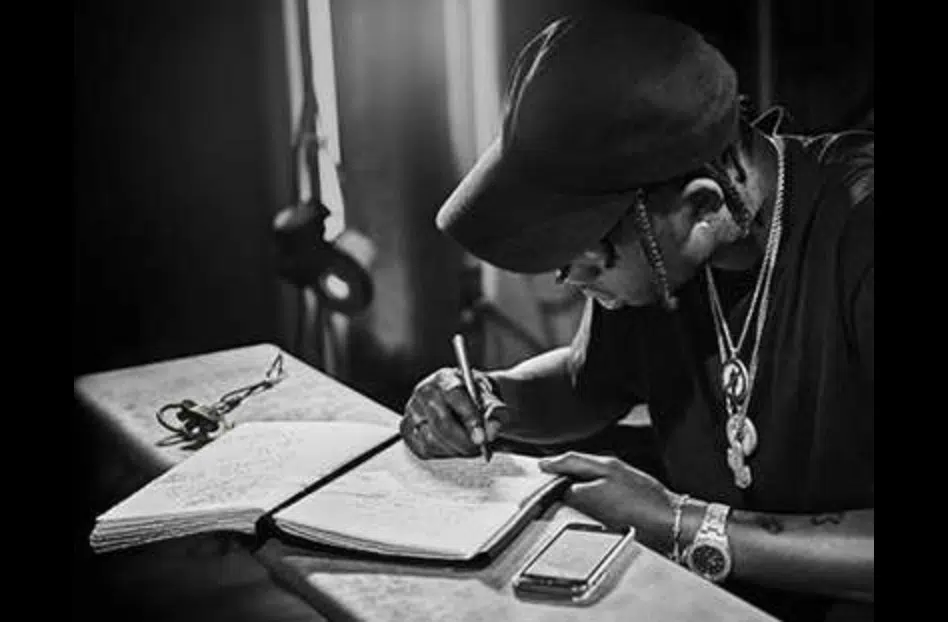
When it comes to songwriting, good lyrics are everything 一 helping to emphasize the emotional power and impact.
They should clearly convey the feelings or storyline you’re aiming for.
This clarity is achieved through careful word choice and sticking to the overall vibe; you’ve got to think about how each line contributes to the big picture.
Try to use vivid language, like metaphors and similes, that can really draw a picture and get people invested.
Structurally, good lyrics should include show-stopping chord progressions that build on the song’s theme or story as they move from verse, bridge, and chorus.
It will keep the listener engaged and include some much-needed tension and release.
Remember, each line, from the opening line to the closing line, should serve a purpose, like pushing the story forward or making certain emotions stronger.
Getting Started (How To Write Better Lyrics)
Now that you understand the fundamentals of good song lyrics, let’s break down the basic steps of starting your lyric writing journey. Remember, when you’re learning how to write lyrics, every good song begins with a spark of inspiration and a solid framework… makes sense, right?
-
How to Find Inspiration For Your Song Lyrics & Develop Your Song Ideas/Themes

Inspiration for your song lyrics can strike anywhere, anytime (often when you least expect it), so you should prepare to capture these moments at the drop of a dime.
Meaning, you should always have a way to record your thoughts, like a notebook, a voice recording app, or your phone.
It’s pretty valuable for developing the themes of your songs and the emotional tone of your lyrics.
Think of how many times you’ve had a good line in your head but couldn’t remember it by the time you got home.
On the other hand, when you actually need to find ideas/inspiration, you can try different songwriting techniques such as:
- Reverse songwriting (think of the end first)
- Drawing from your own personal experiences
- Changing your songwriting atmosphere
Remember, when it comes to writing song lyrics, it’s all about setting the stage, building a signature sound, and telling a story.
There are no rules to songwriting, so don’t dismiss every idea right off the bat…
In fact, challenging yourself to stick with a certain theme for a couple lines or try out a new music genre can actually help you learn how to write lyrics better.
It’s all about getting creative and finding the songwriting process that works best with your unique style.
-
Understanding Song Structure
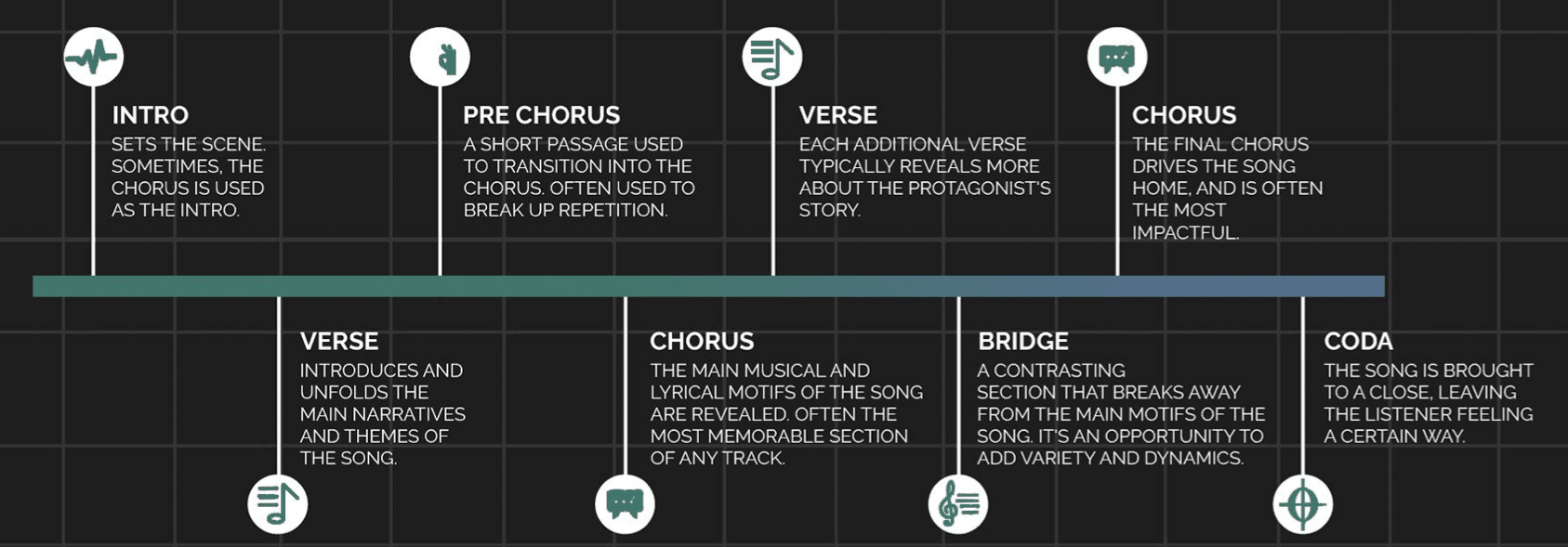
When it comes to songwriting, a solid understanding of song structure can actually make or break how professional people think you are.
Any songwriter learning how to write a song and tell a story people want to hear needs to know different song variations/song forms.
The classic verse-chorus structure is a popular one because it balances repetition and new information, which helps retain the listener’s attention while also providing space for lyrical development.
Each component of the song structure (verse, chorus, bridge) has a role:
- Verses 一 Set the scene and explore the song’s themes.
- Choruses 一 Offer a memorable, repetitive hook people can’t forget.
- Bridges 一 Provide a contrast/build-up that enhances the climax of the song.
Strong song structuring involves knowing what the listener expects and creating segments that either fulfill (or subvert) them to keep their interest.
For instance, introducing a bridge or an instrumental solo can vary the song’s dynamics and provide a fresh perspective before returning to the familiar comfort of the chorus.
-
Building the First Verse

When you start writing music or want to enhance your songwriting skills, the first verse is your opportunity to reel people in and set the tone for the rest of your song.
It should introduce the key themes and provide enough detail to intrigue the listener, without giving everything away, of course.
Start with strong lines that establish the emotional or narrative direction of the song.
Consider the pacing and rhythm of your words in the first verse.
They need to mesh well with the melody and set up the rhythm/rhymic patterns that will be developed throughout the song.
This synchronization helps make the song lyrics more memorable and effective.
Also, make sure that the first verse leads naturally into the chorus, you don’t want things to sound sloppy or unorganized.
You can do this by building lyrical tension or momentum that is then resolved or amplified in the chorus.
Remember, when you’re learning how to write lyrics, it’s all about maintaining the flow of your song and making it impossible for people to turn away.
-
Creating the Chorus

The chorus is the emotional explosion of your song, so it should be super catchy and meaningful (just think: this is where I’m making a statement).
It typically contains the song’s main message or hook, thrown together in a way that is easy to remember and relates to the audience.
When writing your chorus, focus on repetition and strong, bold language.
This repetition will help the chorus get stuck in people’s heads 一 making it the part of the song that people will most likely remember and actually sing along to.
Make sure to use clear, concise, simple language that conveys the core message of the song with unmatched power and heart.
NOTE: The melody of the chorus (first chorus, second chorus, etc.) should be distinct yet coherent with the rest of the song.
It should provide a contrast that highlights the lyrical content.
Keep in mind that it’s important for the transition between verse and chorus to feel seamless and natural, enhancing the overall flow of the song, not ruining it.
-
Writing the Second Verse
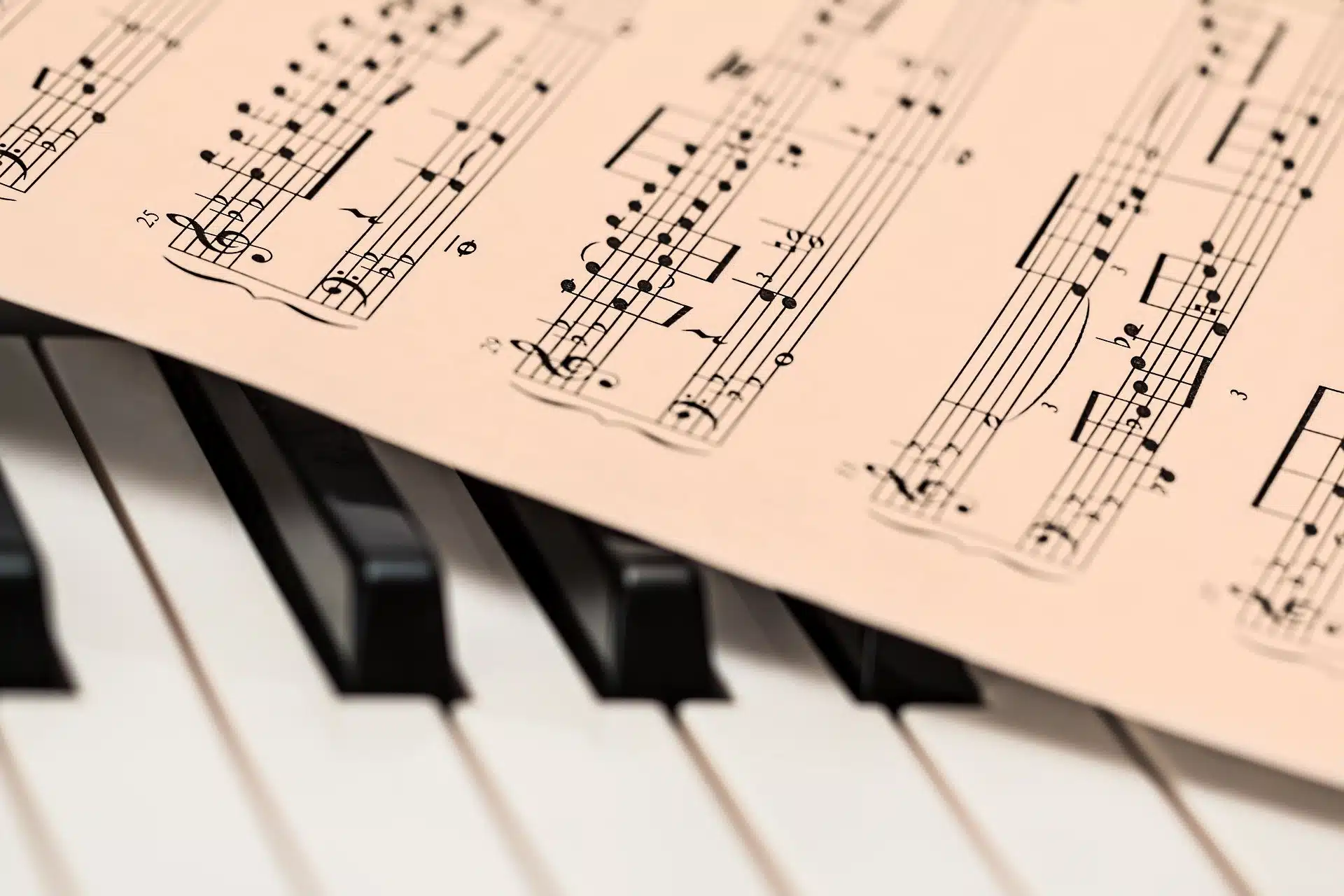
When you write song lyrics for the second verse, they should expand on the ideas introduced in the first verse to provide additional details.
Or, introduce an entirely new perspective of the theme to switch things up.
It’s an opportunity to deepen the listener’s understanding of the song’s subject matter and to maintain their stakes in the musical story you’re creating.
Keep the lyrical content fresh yet consistent.
You could include new information or a twist in the narrative that keeps the song interesting (but still aligns with the overall theme and tone of the song).
Pay attention to how the second verse leads back into the chorus, as well, you don’t want to forget about that 一 cohesion is key when you’re learning how to write lyrics.
Bottom line, the second verse should be just as intriguing as the first and make sense.
-
Breaking Down the Pre-Chorus
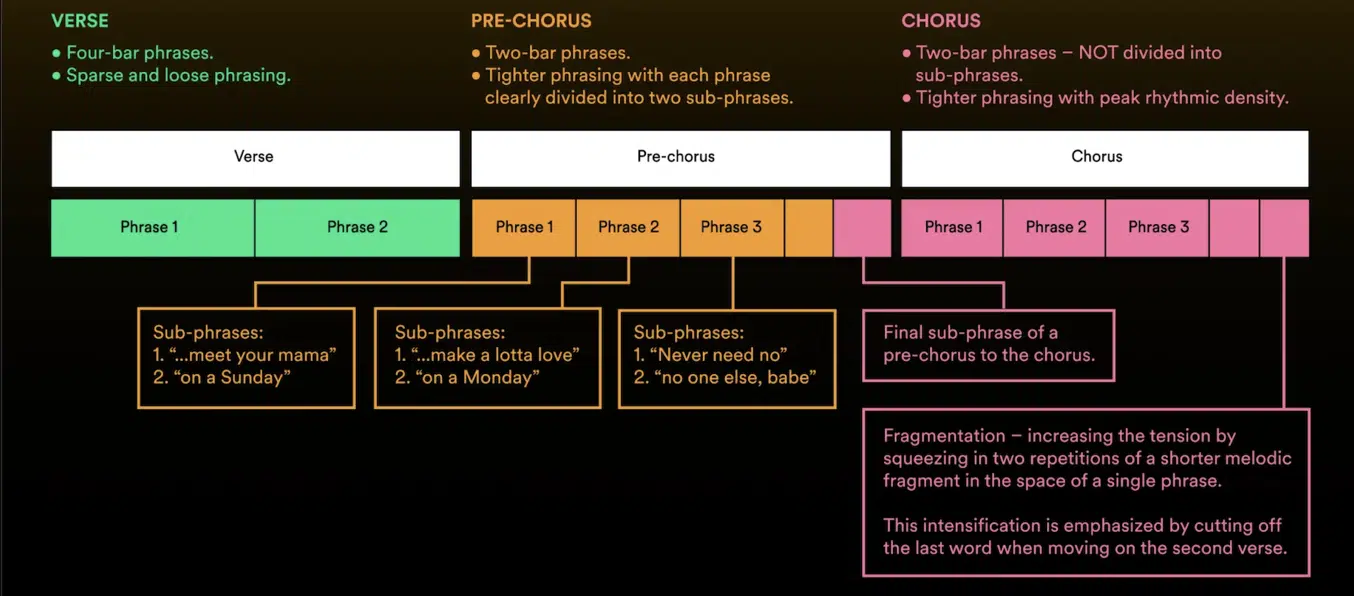
The pre-chorus is a key element of hit song structure, acting as a bridge between the verse and the chorus.
It builds anticipation and sets up the emotional climax that the chorus will resolve.
Remember, if you really want to learn how to write lyrics that make a lasting impression, it’s all about tension and release 一 this is key.
The pre-chorus should escalate the tension or excitement, using both song lyrics and melodies to capture people’s attention and build a bigger picture.
When you’re writing lyrics for your pre-chorus, make sure to focus on creating a lyrical build-up that throws a curve ball, like slower/faster rhyme schemes, yet still vibes.
NOTE: Silence is just as powerful as words when it comes to the pre-chorus because it can add to the tension, so keep that in mind.
Bottom line, the pre-chorus should shift in melody or chord progression to differentiate it from the verses and chorus, either by a little or a lot 一 dealer’s choice.
Just make sure the melodies and chord progressions you choose will draw the audience in and up their emotional ante.
You could also try to draw inspiration from your favorite songs when you write song lyrics to help you get a better understanding and enhance your creative process.
Side note, if you want to learn everything about different types of melodies, we’ve got you covered.
Advanced Lyric Writing Techniques
With the basics of how to write a song down, let’s dive into some more advanced techniques to really polish your lyrics. It will help you refine your style and add depth to your songwriting.
-
Playing with Different Rhyme Schemes

Rhyme schemes, as the name implies, break down the way your lines rhyme with each other, helping to determine your songs overall rhythm and flow.
Common patterns include:
- AABB (where the first two lines rhyme with each other and the next two lines rhyme with each other)
- ABAB (alternating lines rhyme)
- AABA (the first, second, and fourth lines rhyme, creating a sandwich effect with the third line).
Choosing the right scheme can help reinforce your song’s structure and enhance its lyrical impact.
Consider how these patterns can emphasize important words or certain ideas.
For example, an AABB scheme might be used to pair couplets together 一 making each section of the song distinct and memorable.
Play around with different rhyme schemes to see how they change the song’s feel, which will change from song to song.
When exploring rhyme schemes, it’s important to maintain naturalness and avoid forcing words just to achieve a rhyme…
People can tell (for the most part), and they might be turned off by you trying too hard or not being able to make things work.
Remember when you’re learning how to write lyrics, the best line rhymes will sound effortless, fitting, powerful, and relatable.
For example, using slant rhymes (words that almost rhyme, like “heart” and “remark”) is the perfect way to maintain a lyrical flow without seeming whack.
The best songs add that curve, so don’t be afraid to get creative with your word choice.
-
Getting Past Writer’s Block

Writer’s block can suck, that’s a fact… but it’s all about getting creative.
One effective strategy to get past writer’s block is to change your environment or your routine, which is proven to stimulate new ideas.
Simple changes, like writing at a different time of day or in a new location, can refresh your creative process and help overcome mental blocks.
Another technique is to return to the basics: listen to music that inspires you, or revisit old notes and drafts 一 it might reignite a spark.
Collaborating with other songwriters can also provide new insights or ideas you didn’t think of, for a fresh perspective on your lyrical content.
NOTE: Keep a regular writing schedule, but be somewhat flexible so you don’t drive yourself crazy. Setting small, achievable goals can build momentum without the pressure of knocking out the ‘perfect’ verse or chorus right away.
Remember, persistence is key, and every songwriter faces challenges in creative expression, especially when first learning how to write lyrics.
-
Ensuring Your Lyrics and Melody Match

The synergy between song lyrics and melodies is absolutely key for a song’s success.
Your lyrics should naturally fit the rhythm and contours of your melody to enhance the emotional delivery of each line, not destroy it.
This alignment will help you learn how to write lyrics and create songs that feel cohesive and well thought out.
To ensure a good match, vocalize your lyrics as you write them 一 feeling out how they flow with the melody.
This can help detect awkward phrases or rhythms that might disrupt the musicality.
Adjusting syllable counts or emphasizing certain beats can make the lyrics more complementary to the melody.
Consider the emotional tone of both elements…
If your melodies are upbeat, your lyrics shouldn’t be crazy depressing (unless it makes total sense with the vision of the song).
This harmony between great lyrics and melody will undoubtedly enhance the listening experience and make your song lyrics more impactful and memorable.
Writing Song Lyrics: Finishing Touches
After refining and locking down your lyrics and melodies, it’s time to put the finishing touches on your song. This is the final phase in your ‘how to write lyrics’ journey, so make sure to really pay attention. Your song can be amazing, but if you don’t take the time to really bang those little details out, you could be holding it back.
-
Editing and Refining Your Lyrics
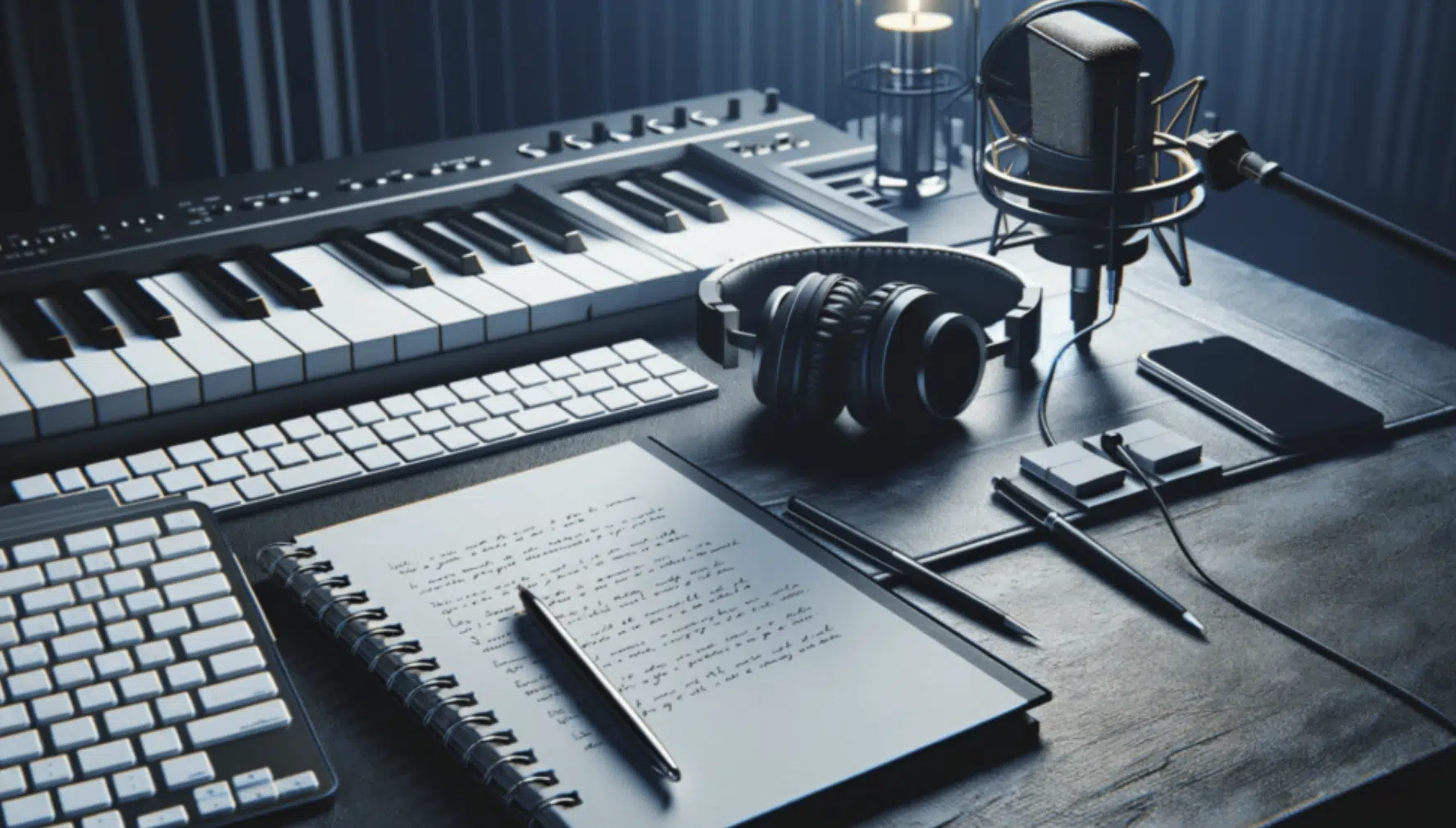
The editing stage is where good lyrics become the best lyrics possible.
So, make sure to:
- Go over your lyrics with fresh ears
- Look for areas that could be improved, clearer, or more impactful
- Think about what you would expect/want to hear
It’s super helpful to read them out loud with the instrumental you’re planning on using to really envision the end product.
Also, please look for any cliches or overused phrases and consider how you can make them more original (you don’t want people to think you’re not creative).
Feedback is also a vital part of the songwriting process.
So, sharing your best lyrics and hearing some insights from your songwriting community can tell you how other people will perceive it.
NOTE: Focus on patterns or recurring comments when you’re getting feedback and, even though it could be hard sometimes, be open to suggestions.
If multiple listeners point out the same issue, you should probably tweak it.
Remember, good song lyrics don’t just burst out of thin air 一 there’s always adjustments needing to be made, it doesn’t mean you’re bad at writing good songs.
-
Pro Tip: A Rhyming Dictionary Might Help
A rhyming dictionary can be super helpful when it comes to the writing process.
It can help you find the perfect rhyme/single word, expand your options, and discover creative line endings that you might not have considered.
NOTE: While it’s great for generating ideas, always make sure that the line rhymes fit naturally into your song’s context.
Don’t force a rhyme just because it’s clever 一 again, it should always feel natural and vibe with the song’s overall flow and message.
-
Taking Advantage of Software for Better Lyrics
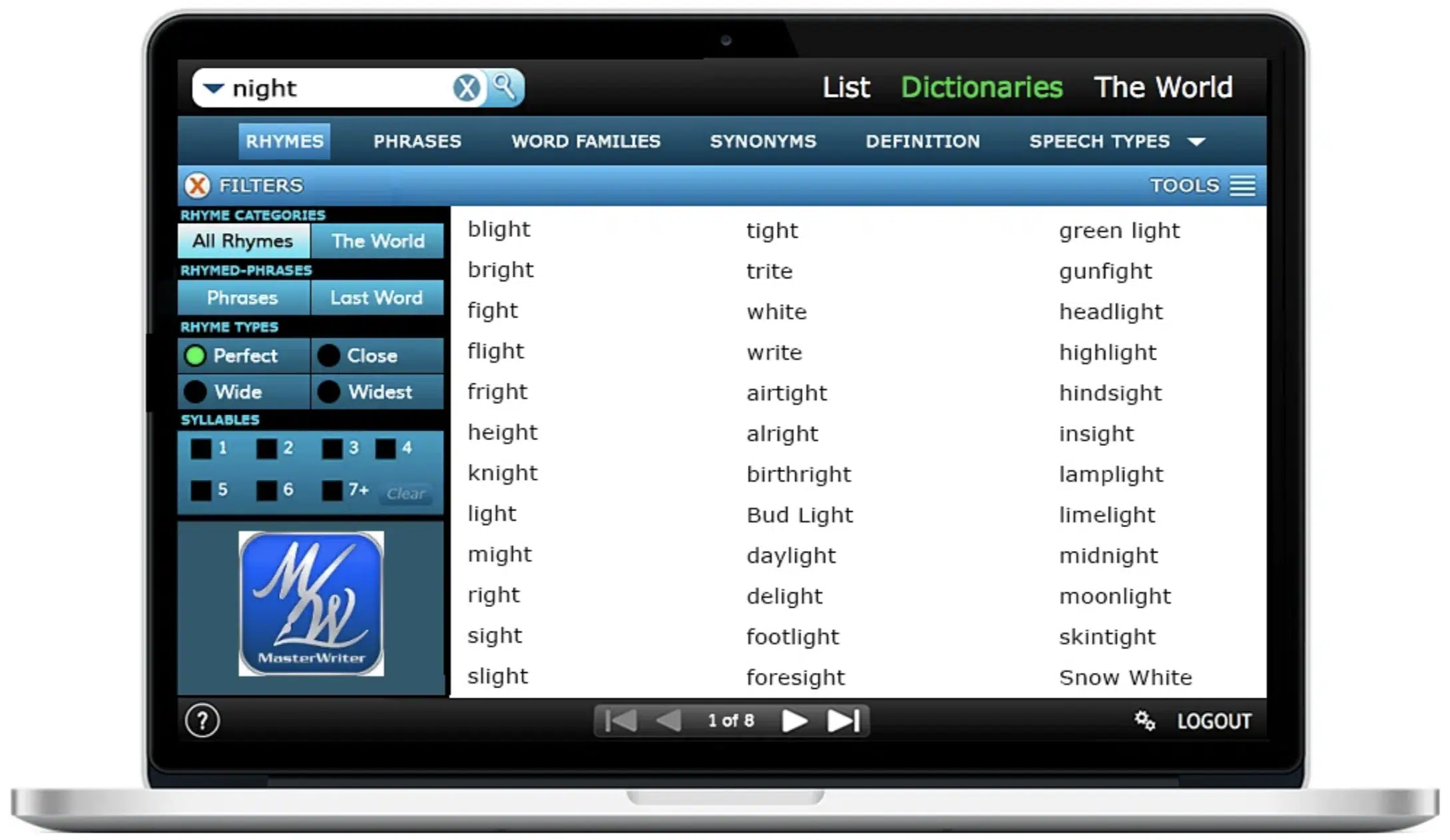
When you’re writing songs, sometimes it’s useful to try out some digital tools to streamline the songwriting process.
Whether you need help with your first line, second line, or how lyrics work in general, there’s an app for that.
Honestly, most songs you wouldn’t even expect were written with their assistance.
Software like MasterWriter or RhymeGenie is pretty solid, including extensive rhyme dictionaries and phrase suggestions that can inspire or refine your lyrics.
They provide various options to get different lyrical ideas quickly.
Additionally, apps like Songwriter’s Pad or Tully offer structured environments for writing lyrics, organizing song ideas, and even recording quick demos.
These tools are designed specifically for songwriters, so they can help you:
- Visualize song structures
- Manage different versions of song lyrics
- Experiment with various lyrical arrangements
Now, while these digital tools are valuable in helping you write song lyrics, they should complement rather than replace your unique style.
Use them to enhance your understanding of song structure and to experiment with new lyrical concepts, not just write them for you.
Always make sure you’re writing song lyrics that are authentic to you.
From the song title to the closing line, it should be 100% you… it’s the key to a great song and a future big hit.
How to Write Lyrics: Final Thoughts
Learning how to write lyrics that resonate deeply with your audience and actually make a lasting impression is not so easy.
It takes dedication, a deep understanding of musical structure, and the skills to tell a story with each word.
As well as being able to convey different emotions and overcome songwriting challenges, of course.
However, by using the techniques and methods in today’s article, you’ll be able to write lyrics like a true professional.
If you’re serious about taking your songwriting to the next level, you’ve got to check out the highly-renowned #1 Songwriting Course in the game.
With this course, you’ll discover the secrets to writing hit songs that get you noticed in the music industry.
It will help you create songs that people can’t forget, become a top-tier songwriter, and blow the competition out of the water.
Plus, it comes with three (exclusive) mind-blowing bonuses, which never hurts.
So, now that you have all the resources to learn how to write lyrics that aren’t basic, boring, or amateurish, it’s time to go and try them out!
P.s., make sure to keep a calm head and really put your heart into it (this is key).
Until next time…







Leave a Reply
You must belogged in to post a comment.